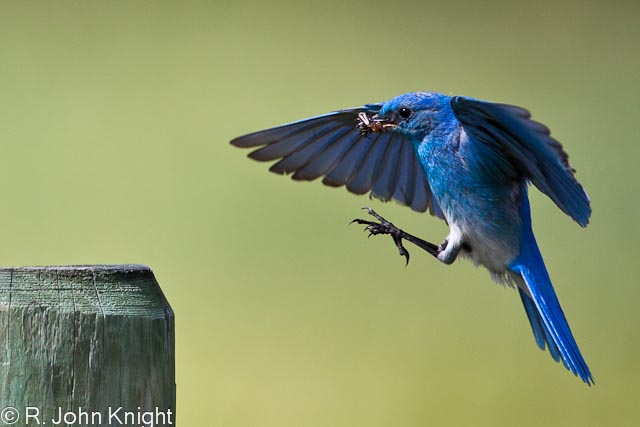While exploring the area east of Logan Lake and north towards Tunkwa Provincial Park , central British Columbia
We stopped near one the bird houses late one afternoon. For awhile, nothing happened, but then a female Bluebird settled onto the barbed-wire fence about 15 m away. A little while later, a male landed atop a fence post about the same distance in the opposite direction. Both sat, cautiously eyeing us. After a while, they flew away.
 |
| Female with a mouthful of food |
 |
| Male watching us carefully |
This pattern was repeated several times, but they never came any closer. We eventually concluded that they were uncomfortable with us being there, so we headed off.
The next day, we setup near an active nest along a road that had more vehicle traffic. It didn’t take long to see a male and a female fly in and perch about 15 m away on a tree branch, bush, or distant fence post, watching us. After a while, the male flew to a closer fence post, then another. With each pause, he carefully watched. And then suddenly, for no apparent reason, he flew away.
When he returned, the process of inching towards us, fence post by fence post, was repeated. Eventually, the male landed on the fence post directly opposite us. He paused briefly, and then flew directly to the adjacent bird house. As he flew by, we could see that his beak was loaded with bugs for the four hungry chicks in the nest. Once he left, the female cautiously repeated the same flight path.
 |
| Male watching while the female visits the nest |
 |
| Got to look good! |
The adults took turns visiting the nest every few minutes. If you listened carefully, you could hear the excited sounds of the chicks when one of the adults arrived.
 |
| Yummy, yummy, a nice juicy grub! |
While the adult’s flight paths were not exactly the same each time, there was a rough pattern as they approached the nest. With this in mind, we decided to see if it was possible to photograph the birds in flight. This was going to be a challenge because their flight speed was clearly too fast and erratic for a pan shot.
With our photographic gear setup about 4-5 m from the fence post adjacent to the nest, we pre-focused our cameras at an imaginary window through which the Bluebirds had to fly either to land or take-off. Initially, we tried focusing on the leading edge of the post, and then made slight adjustments for their assumed flight path. When this didn’t work, one of us would walk over to the fence post when the adults were away, and hold a hand in the flight path for others focus on.
Then the first challenge was when to fire and hold the shutter down to catch the Bluebirds flying through your imaginary flight window. During my initial attempts, nothing was captured. After adjusting my timing, I managed to get a part of a Bluebird entering or leaving our imaginary window, but still nothing was in focus. It took two half days of patience and adjustments to my timing and the camera’s focus to get one good image. Thank goodness for digital cameras.
 |
| Finally caught one in flight! |
For most of the year, there is little activity at these bird houses. Once a nesting pair of birds arrives in the spring, these little bird houses become a centre of activity for a short period of time. Thank you to the volunteers who install and maintain these bird houses. It would be tough to get images of Mountain Bluebirds such as these without the bird houses.
Camera Setup: Canon 5D MkII, 500 mm lens, Gitzo tripod with a Wimberley (or Mongoose) head.
Camera Settings: Manual focus, 1/6400 at F5.0, ISO 400-800 depending on amount of sunlight, and 4 fps to stop the action and keep the background out of focus.









